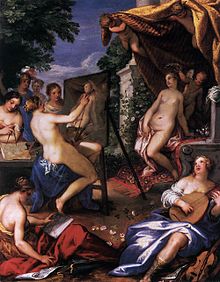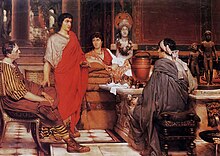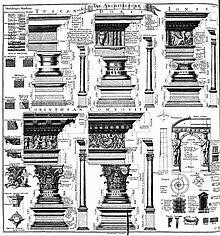Practice for Music and Art How Are Practice for Music and Art the Same
The arts are a very wide range of human practices of artistic expression, storytelling and cultural participation. They embrace multiple diverse and plural modes of thinking, doing and existence, in an extremely wide range of media. Both highly dynamic and a characteristically constant feature of human life, they have developed into innovative, stylized and sometimes intricate forms. This is ofttimes achieved through sustained and deliberate study, grooming and/or theorizing within a particular tradition, across generations and even between civilizations. The arts are a vehicle through which homo beings cultivate distinct social, cultural and private identities, while transmitting values, impressions, judgments, ideas, visions, spiritual meanings, patterns of life and experiences beyond time and infinite.
Prominent examples of the arts include compages, visual arts (including ceramics, drawing, filmmaking, painting, photography, and sculpting), literary arts (including fiction, drama, poetry, and prose), performing arts (including dance, music, and theatre), textiles and manner, folk art and handicraft, oral storytelling, conceptual and installation art, criticism, and culinary arts (including cooking, chocolate making and winemaking). They can use skill and imagination to produce objects, performances, convey insights and experiences, and construct new environments and spaces.
The arts can refer to common, popular or everyday practices also as more sophisticated and systematic, or institutionalized ones. They can be discrete and self-contained, or combine and interweave with other art forms, such equally the combination of artwork with the written word in comics. They can also develop or contribute to some item aspect of a more complex art course, as in cinematography.
By definition, the arts themselves are open up to existence continually re-defined. The practice of modern art, for example, is a attestation to the shifting boundaries, improvisation and experimentation, reflexive nature, and cocky-criticism or questioning that fine art and its conditions of product, reception, and possibility tin undergo.
As both a means of developing capacities of attention and sensitivity, and as ends in themselves, the arts can simultaneously be a grade of response to the world, and a way that our responses, and what nosotros deem worthwhile goals or pursuits, are transformed. From prehistoric cavern paintings, to aboriginal and contemporary forms of ritual, to mod-day films, fine art has served to register, embody and preserve our ever shifting relationships to each other and to the world.
Definition

At that place are several possible meanings for the definitions of the terms Art and Arts.[a] The first meaning of the word fine art is « way of doing ».[1] The most bones present meaning defines the arts as specific activities that produce sensitivity in humans.[two] The arts are also referred to equally bringing together all creative and imaginative activities, without including science.[b] [iii] [4] In its well-nigh basic abstract definition, fine art is a documented expression of a sentient being through or on an accessible medium so that anyone can view, hear or experience it. The deed itself of producing an expression tin as well be referred to as a certain art, or equally art in general. Whether this solidified expression, or the act of producing it, is "skillful" or has value depends on those who access and rate it. Such public rating is dependent on various subjective factors. Merriam-Webster defines "the arts" every bit "painting, sculpture, music, theatre, literature, etc., considered every bit a grouping of activities done past people with skill and imagination."[5] Similarly, the Us Congress, in the National Foundation on the Arts and Humanities Act, defined "the arts" as follows:
The term "the arts" includes, just is not limited to, music (instrumental and vocal), trip the light fantastic, drama, folk fine art, creative writing, compages and allied fields, painting, sculpture, photography, graphic and arts and crafts arts, industrial design, costume and fashion pattern, move pictures, television, radio, film, video, record and sound recording, the arts related to the presentation, performance, execution, and exhibition of such major fine art forms, all those traditional arts adept by the diverse peoples of this country. (sic) and the study and application of the arts to the human environment.[vi]
Art is a global activity in which a big number of disciplines are included, such every bit: fine arts, liberal arts, visual arts, decorative arts, applied arts, pattern, crafts, performing arts,[3] ... Nosotros are talking about "the arts" when several of them are mentioned: "As in all arts the enjoyment increases with the knowledge of the art".[7]
The arts tin can be divided into several areas, the fine arts which join, in the broad sense, all the arts whose aim is to produce truthful aesthetic pleasure,[8] decorative arts and applied arts which relate to an artful side in everyday life.[9]
History

The earliest surviving form of any of the arts are cave paintings, perhaps from 70,000 BCE, but definitely from at least 40,000 BCE.[10] The oldest known musical musical instrument, the purported Divje Infant Flute—made from a immature cave bear femur—is dated to 43,000 and 82,000 BCE, just whether it is truly a musical instrument (or an object created past animals) remains extremely controversial.[11] The earliest objects whose designations as musical instruments are widely accepted are 8 bone flutes from the Swabian Jura, Germany; three of these from the Geissenklösterle are dated every bit the oldest, c. 43,150–39,370 BP.[12] The earliest surviving literature appears much later; the Instructions of Shuruppak and Kesh temple hymn amid other Sumerian cuneiform tablets, are thought to only be from 2600 BCE.[13]
In Ancient Greece, all fine art and craft was referred to by the same word, techne. Thus, there was no distinction among the arts. Aboriginal Greek fine art brought the veneration of the fauna form and the development of equivalent skills to bear witness musculature, poise, beauty, and anatomically correct proportions. Ancient Roman fine art depicted gods equally idealized humans, shown with feature distinguishing features (due east.thou. Zeus' thunderbolt). In Byzantine and Gothic art of the Middle Ages, the dominance of the church building insisted on the expression of biblical truths. Eastern art has generally worked in a manner akin to Western medieval fine art, namely a concentration on surface patterning and local colour (meaning the plain colour of an object, such as basic red for a red robe, rather than the modulations of that colour brought about by light, shade and reflection). A characteristic of this manner is that the local colour is ofttimes defined by an outline (a gimmicky equivalent is the cartoon). This is evident in, for instance, the art of India, Tibet and Japan. Religious Islamic art forbids iconography, and instead expresses religious ideas through calligraphy and geometrical designs.
Classifications

In the Heart Ages, the Artes Liberales (liberal arts) were taught in universities as part of the Trivium, an introductory curriculum involving grammar, rhetoric, and logic,[14] and of the Quadrivium, a curriculum involving the "mathematical arts" of arithmetic, geometry, music, and astronomy.[xv] The Artes Mechanicae (consisting of vestiaria – tailoring and weaving; agricultura – agronomics; architectura – architecture and masonry; militia and venatoria – warfare, hunting, military education, and the martial arts; mercatura – trade; coquinaria – cooking; and metallaria – blacksmithing and metallurgy)[xvi] [ not specific enough to verify ] were practised and developed in guild environments. The modern stardom betwixt "artistic" and "not-creative" skills did not develop until the Renaissance. In modern academia, the arts are usually grouped with or as a subset of the humanities. Some subjects in the humanities are history, linguistics, literature, theology, philosophy, and logic.
The arts have also been classified equally seven: painting, architecture, sculpture, literature, music, performing and cinema. Some view literature, painting, sculpture, and music as the chief four arts, of which the others are derivative; drama is literature with acting, dance is music expressed through motion, and song is music with literature and voice.[17] Film is sometimes called the "eighth" and comics the "ninth fine art".[xviii]
Visual arts
Compages

Architecture is the art and science of designing buildings and structures. The word architecture comes from the Greek arkhitekton, "master architect, managing director of works," from αρχι- (arkhi) "master" + τεκτων (tekton) "architect, carpenter".[19] A wider definition would include the design of the built environment, from the macrolevel of town planning, urban blueprint, and landscape architecture to the microlevel of creating article of furniture. Architectural design usually must address both feasibility and cost for the builder, besides as function and aesthetics for the user.

In modern usage, compages is the art and field of study of creating, or inferring an implied or apparent plan of, a complex object or arrangement. The term can be used to connote the implied architecture of abstruse things such every bit music or mathematics, the credible architecture of natural things, such as geological formations or the structure of biological cells, or explicitly planned architectures of homo-made things such as software, computers, enterprises, and databases, in addition to buildings. In every usage, an architecture may be seen as a subjective mapping from a human perspective (that of the user in the example of abstract or physical artifacts) to the elements or components of some kind of construction or organization, which preserves the relationships among the elements or components. Planned architecture manipulates space, volume, texture, lite, shadow, or abstract elements in social club to achieve pleasing aesthetics. This distinguishes it from applied science or engineering, which usually concentrate more on the functional and feasibility aspects of the blueprint of constructions or structures.
In the field of building architecture, the skills demanded of an architect range from the more circuitous, such every bit for a infirmary or a stadium, to the apparently simpler, such equally planning residential houses. Many architectural works may be seen likewise as cultural and political symbols, or works of art. The role of the architect, though changing, has been key to the successful (and sometimes less than successful) design and implementation of pleasingly built environments in which people alive.
Ceramics
Ceramic art is fine art made from ceramic materials (including clay), which may have forms such as pottery, tile, figurines, sculpture, and tableware. While some ceramic products are considered fine art, some are considered to be decorative, industrial, or applied fine art objects. Ceramics may also be considered artefacts in archaeology. Ceramic art can exist made by one person or past a group of people. In a pottery or ceramic mill, a grouping of people design, manufacture, and decorate the pottery. Products from a pottery are sometimes referred to every bit "art pottery." In a one-person pottery studio, ceramists or potters produce studio pottery. In modern ceramic engineering usage, "ceramics" is the art and scientific discipline of making objects from inorganic, non-metallic materials past the action of oestrus. It excludes drinking glass and mosaic made from glass tesserae.
Conceptual art
Conceptual art is fine art wherein the concept(s) or thought(s) involved in the work take precedence over traditional aesthetic and cloth concerns. The inception of the term in the 1960s referred to a strict and focused practice of idea-based art that oft defied traditional visual criteria associated with the visual arts in its presentation every bit text.[twenty] Through its association with the Immature British Artists and the Turner Prize during the 1990s,[21] its popular usage, particularly in the United Kingdom, developed as a synonym for all contemporary art that does not practise the traditional skills of painting and sculpture.
Drawing
Drawing is a means of making an image, using whatsoever of a wide multifariousness of tools and techniques. It generally involves making marks on a surface by applying pressure from a tool, or moving a tool across a surface. Mutual tools are graphite pencils, pen and ink, inked brushes, wax colour pencils, crayons, charcoals, pastels, and markers. Digital tools which tin can simulate the effects of these are also used. The principal techniques used in drawing are line drawing, hatching, crosshatching, random hatching, scribbling, stippling, and blending. An creative person who excels in drawing is referred to every bit a drafter, draftswoman, or draughtsman.[22] Drawing tin be used to create fine art used in cultural industries such as illustrations, comics and animation. Comics are often called the "ninth art" (le neuvième art) in Francophone scholarship, adding to the traditional "Seven Arts".[23]
Painting

Painting is a mode of creative expression, and can be washed in numerous forms. Drawing, gesture (as in gestural painting), composition, narration (every bit in narrative art), or abstraction (equally in abstract art), among other aesthetic modes, may serve to manifest the expressive and conceptual intention of the practitioner.[24] Paintings can be naturalistic and representational (every bit in a yet life or landscape painting), photographic, abstract, narrative, symbolistic (as in Symbolist art), emotive (every bit in Expressionism), or political in nature (every bit in Artivism).
Modern painters accept extended the practice considerably to include, for case, collage. Collage is not painting in the strict sense since it includes other materials. Some modern painters comprise different materials such as sand, cement, straw, wood or strands of hair for their artwork texture. Examples of this are the works of Jean Dubuffet or Anselm Kiefer.
Photography
Photography as an fine art course refers to photographs that are created in accordance with the artistic vision of the lensman. Fine art photography stands in contrast to photojournalism, which provides a visual account for news events, and commercial photography, the primary focus of which is to advertise products or services.
Sculpture
Sculpture is the branch of the visual arts that operates in iii dimensions. Information technology is i of the plastic arts. Durable sculptural processes originally used etching (the removal of material) and modelling (the addition of material, as clay), in stone, metallic, ceramics, forest and other materials; simply since modernism, shifts in sculptural procedure led to an almost complete freedom of materials and process. A wide variety of materials may exist worked by removal such as etching, assembled by welding or modelling, or moulded, or bandage.
Literary arts
Literature is literally "acquaintance with letters" equally in the commencement sense given in the Oxford English Lexicon. The substantive "literature" comes from the Latin word littera meaning "an individual written graphic symbol (alphabetic character)." The term has more often than not come to place a collection of writings, which in Western civilization are mainly prose (both fiction and non-fiction), drama and verse. In much, if not all of the globe, the creative linguistic expression can exist oral likewise, and include such genres as epic, fable, myth, carol, other forms of oral poetry, and as folktale. Comics, the combination of drawings or other visual arts with narrating literature, are often called the "ninth art" (le neuvième fine art) in Francophone scholarship.[23]
Performing arts
Performing arts comprise dance, music, theatre, opera, mime, and other art forms in which a human operation is the principal product. Performing arts are distinguished by this performance chemical element in contrast with disciplines such as visual and literary arts where the product is an object that does not require a functioning to be observed and experienced. Each subject area in the performing arts is temporal in nature, meaning the production is performed over a period of time. Products are broadly categorized as being either repeatable (for case, by script or score) or improvised for each performance.[25] Artists who participate in these arts in front of an audience are called performers, including actors, magicians, comedians, dancers, musicians, and singers. Performing arts are also supported past the services of other artists or essential workers, such as songwriting and stagecraft. Performers frequently conform their advent with tools such as costume and phase makeup.
Dance

Dance (from Erstwhile French dancier, of unknown origin) by and large refers to human movement either used as a form of expression or presented in a social, spiritual or performance setting.[26] Trip the light fantastic is too used to describe methods of not-exact advice (see torso language) between humans or animals (e.g. bee trip the light fantastic toe, mating trip the light fantastic toe), motion in inanimate objects (eastward.g. the leaves danced in the wind), and certain musical forms or genres. Choreography is the art of making dances, and the person who does this is called a choreographer. Definitions of what constitutes dance are dependent on social, cultural, aesthetic, artistic and moral constraints and range from functional movement (such as Folk dance) to codified, virtuoso techniques such equally ballet. In sports, gymnastics, effigy skating and synchronized swimming are dance disciplines while Martial arts "kata" are often compared to dances.
Music

Music is an art form whose medium is sound and silence, occurring in fourth dimension. Mutual elements of music are pitch (which governs melody and harmony), rhythm (and its associated concepts tempo, metre, and articulation), dynamics, and the sonic qualities of timbre and texture. The creation, operation, significance, and even the definition of music vary according to culture and social context. Music ranges from strictly organized compositions (and their reproduction in performance) through improvisational music to aleatoric pieces. Music can exist divided into genres and subgenres, although the dividing lines and relationships betwixt music genres are oftentimes subtle, sometimes open to individual interpretation, and occasionally controversial. Within "the arts", music may be classified as a performing art, a fine art, and auditory art.
Theatre
Theatre or theater (from Greek theatron (θέατρον); from theasthai, "behold"[27]) is the branch of the performing arts concerned with acting out stories in forepart of an audience using combinations of speech, gesture, music, dance, sound and spectacle – indeed, whatever one or more than elements of the other performing arts. In addition to the standard narrative dialogue mode, theatre takes such forms as opera, ballet, mime, kabuki, classical Indian trip the light fantastic, Chinese opera and mummers' plays.
Multidisciplinary artistic works
Areas exist in which creative works incorporate multiple artistic fields, such every bit film, opera and performance art. While opera is often categorized in the performing arts of music, the discussion itself is Italian for "works", considering opera combines several artistic disciplines in a atypical artistic feel. In a typical traditional opera, the entire work utilizes the post-obit: the sets (visual arts), costumes (manner), acting (dramatic performing arts), the libretto, or the words/story (literature), and singers and an orchestra (music).

The composer Richard Wagner recognized the fusion of so many disciplines into a single work of opera, exemplified by his cycle Der Ring des Nibelungen ("The Ring of the Nibelung"). He did not use the term opera for his works, but instead Gesamtkunstwerk ("synthesis of the arts"), sometimes referred to equally "Music Drama" in English, emphasizing the literary and theatrical components which were equally important as the music. Classical ballet is another grade which emerged in the 17th century in which orchestral music is combined with trip the light fantastic toe.
Other works in the tardily 19th, 20th and 21st centuries have fused other disciplines in unique and creative ways, such as performance art. Performance fine art is a performance over time which combines any number of instruments, objects, and fine art inside a predefined or less well-defined construction, some of which tin be improvised. Performance art may be scripted, unscripted, random or advisedly organized; even audience participation may occur. John Cage is regarded by many as a performance artist rather than a composer, although he preferred the latter term. He did non etch for traditional ensembles. Cage's composition Living Room Music equanimous in 1940 is a "quartet" for unspecified instruments, really non-melodic objects, which tin can be found in a living room of a typical house, hence the title.
Other arts
There is no clear line between art and civilization. Cultural fields like gastronomy are sometimes considered equally arts.[28]
Applied arts
The practical arts are the awarding of design and decoration to everyday, functional, objects to brand them aesthetically pleasing.[29] The practical arts includes fields such equally industrial design, analogy, and commercial art.[thirty] The term "practical art" is used in distinction to the fine arts, where the latter is defined as arts that aims to produce objects which are beautiful or provide intellectual stimulation only have no chief everyday function. In practise, the ii often overlap.
Video games
A debate exists in the fine arts and video game cultures over whether video games can be counted as an art form.[31] Game designer Hideo Kojima professes that video games are a type of service, not an fine art form, because they are meant to entertain and attempt to entertain every bit many people as possible, rather than beingness a unmarried artistic vocalisation (despite Kojima himself beingness considered a gaming auteur, and the mixed opinions his games typically receive). However, he acknowledged that since video games are made up of artistic elements (for example, the visuals), game designers could exist considered museum curators – not creating artistic pieces, but arranging them in a manner that displays their artistry and sells tickets.
Within social sciences, cultural economists evidence how video games playing is conducive to the involvement in more than traditional art forms and cultural practices, which suggests the complementarity between video games and the arts.[32]
In May 2011, the National Endowment of the Arts included video games in its redefinition of what is considered a "work of art" when applying for a grant.[33] In 2012, the Smithsonian American Art Museum presented an showroom, The Art of the Video Game.[34] Reviews of the showroom were mixed, including questioning whether video games vest in an fine art museum.
Arts criticism
- Architecture criticism
- Art criticism
- Dance criticism
- Film criticism
- Music criticism
- Television criticism
- Theatre criticism
- Literary criticism
See as well
- Arts in education
- The arts and politics
Notes
- ^ The term Art comes from the Latin ars, artis.
- ^ Historically, science has long been opposed to fine art, considering art was characterised as a subject field that could not exist learned (dissimilar scientific discipline).
References
- ^ Valéry 1935, p. 683.
- ^ "Définition de l'art" [Definition of art] (in French). Éditions Larousse. Archived from the original on 31 March 2021. Retrieved 7 June 2020.
- ^ a b "Fine art Definition: Significant, Classification of Visual Arts". visual-arts-cork.com. Archived from the original on xxx May 2020. Retrieved 7 June 2020.
- ^ "The arts definition and meaning". Collins English Dictionary. Archived from the original on 11 July 2017. Retrieved 7 June 2020.
- ^ "Definition of The Arts by Merriam-Webster". Merriam-Webster. Archived from the original on 1 June 2017. Retrieved 14 May 2017.
- ^ Van Military camp 2006.
- ^ Hemingway 2003, p. 11.
- ^ "Définition de Beaux-Arts" [Definition of Fine Arts] (in French). Bayard Presse. Archived from the original on 8 June 2020. Retrieved 8 June 2020.
The fine arts include painting, sculpture, certain graphic arts and architecture. Music and poetry are sometimes chosen fine fine art.
- ^ "Définition de arts appliqués" [Definition of applied arts] (in French). Fifty'Internaute. Archived from the original on eight June 2020. Retrieved eight June 2020.
The applied arts join nether one banner all the activities that bring an aesthetic side to everyday life. These arts are practiced by designers, who are in charge of embellishing what surrounds the individual.
- ^ St. Fleur 2018, p. 10.
- ^ Morley 2013, pp. 38–39.
- ^ Morley 2013, pp. 42–43.
- ^ Diedrich 2015, p. i.
- ^ Onions, Friedrichsen & Burchfield 1991, p. 994.
- ^ . The New International Encyclopædia. 1905 – via Wikisource.
The quadrivium consisted of arithmetic, music, geometry, and astronomy.
- ^ In his commentary on Martianus Capella'south early 5th century work, The Wedlock of Philology and Mercury, one of the main sources for medieval reflection on the liberal arts
- ^ Rowlands & Landauer 2001.
- ^ Ryynänen, Max (2020). On the Philosophy of Central European Fine art: The History of an Establishment and Its Global Competitors. Lanham: Rowman & Littlefield. p. 37. ISBN978-1-7936-3418-4.
- ^ Harper 2016.
- ^ LeWitt 1967, pp. 79–83.
- ^ Huntsman 2015, p. 221.
- ^ "The definition of draftsman". Dictionary.com. Archived from the original on 29 October 2016. Retrieved 29 October 2016.
- ^ a b Miller 2007, p. 23.
- ^ Perry 2014, p. 85.
- ^ Honderich 2006.
- ^ Fraleigh 1987, p. iii.
- ^ Harper, Douglas (2001–2016). "theater (north.)". Online Etymology Lexicon. Archived from the original on 30 October 2016. Retrieved 29 October 2016.
- ^ Desai, DeSimone & Henig 2013.
- ^ Chilvers 2004, p. 29.
- ^ "Define Applied fine art at Dictionary.com". Dictionary.com. Archived from the original on 31 July 2017. Retrieved viii May 2018.
- ^ Parker 2012, p. 42.
- ^ Borowiecki & Prieto-Rodriguez 2013, pp. 239–258.
- ^ Barber 2012.
- ^ Parker 2012, p. 46.
Sources
- Chilvers, Ian (2004). The Oxford Lexicon of Art (3rd ed.). Oxford: Oxford University Press. ISBN978-0-19-860476-ane.
- Fraleigh, Sondra Horton (1987). Dance and the Lived Body: A Descriptive Aesthetics. Pittsburgh, Pa.: Academy of Pittsburgh Press. ISBN978-0-8229-7170-ii.
- Hemingway, Ernest (2003) [1932]. "1". Death in the Afternoon (1st Scribner merchandise pbk. ed.). New York: Charles Scribner'south Sons. ISBN978-0-684-85922-iv.
- Honderich, Ted (2006). The Oxford companion to philosophy. Oxford University Press. doi:10.1093/acref/9780199264797.001.0001. ISBN978-0-nineteen-926479-7.
- Huntsman, Penny (28 September 2015). Thinking About Art: A Thematic Guide to Fine art History. Chichester, West Sussex, UK: Wiley. ISBN978-i-118-90517-3.
- Miller, Ann (2007). Reading bande dessinée : disquisitional approaches to French-language comic strip. ISBN978-ane-84150-177-two.
- Morley, Iain (2013). The Prehistory of Music: Human being Evolution, Archeology, and the Origins of Musicality. Oxford: Oxford University Printing. ISBN978-0-19-923408-0.
- Onions, Charles Talbut; Friedrichsen, George Washington Salisbury; Burchfield, Robert William (1991). The Oxford lexicon of English language etymology. Oxford: at The Clarendon Printing. ISBN978-0-19-861112-vii.
- LeWitt, Solomon (June 1967). "Paragraphs on Conceptual Fine art". Artforum. Vol. v, no. 10. Archived from the original on 26 July 2020. Retrieved 12 May 2020.
- Borowiecki, Karol J.; Prieto-Rodriguez, Juan (2013). "Video Games Playing: A substitute for cultural consumptions?". Journal of Cultural Economics. 39 (3): 239–258. CiteSeerX10.1.1.676.2381. doi:10.1007/s10824-014-9229-y. S2CID 49572910.
- Diedrich, Cajus G. (1 April 2015). "'Neanderthal bone flutes': just products of Ice Age spotted hyena scavenging activities on cave bear cubs in European cave bear dens". Open Scientific discipline. 2 (4): 140022. Bibcode:2015RSOS....240022D. doi:10.1098/rsos.140022. PMC4448875. PMID 26064624.
- Parker, Felan (12 December 2012). "An Art World for Artgames". Loading... 7 (eleven). ISSN 1923-2691. Archived from the original on 26 December 2016. Retrieved 14 May 2017.
- Perry, Lincoln (Summer 2014). "The Music of Painting". The American Scholar. 83 (3).
- Barber, Bonnie (16 August 2012). "Professor Mary Flanagan Participates in White House Consortium". Darthmouth News. Archived from the original on 26 July 2020. Retrieved 13 May 2020.
- St. Fleur, Nicholas (12 September 2018). "Oldest Known Drawing by Human Hands Discovered in South African Cave". The New York Times. Archived from the original on xiv April 2020. Retrieved 7 April 2020.
- Desai, Trex; DeSimone, Frank; Henig, Sarit (xx December 2013). "The New Confront of French Gastronomy - Knowledge@Wharton". knowledge.wharton.upenn.edu. Wharton Schoolhouse of the University of Pennsylvania. Archived from the original on 12 September 2017. Retrieved 8 May 2018.
- "The Art of Video Games". SI.edu. Smithsonian American Art Museum. Archived from the original on ten Jan 2011. Retrieved 7 March 2015.
- "Conceptual fine art". Tate Glossary. Archived from the original on 20 March 2015. Retrieved 7 March 2015.
- "FY 2012 Arts in Media Guidelines". Endow.gov. National Endowment for the Arts. Archived from the original on xiii February 2012. Retrieved vii March 2015.
- Harper, Douglas (2016). "Origin and meaning of architect past Online Etymology Dictionary". Online Etymology Dictionary. Archived from the original on nineteen March 2016. Retrieved 29 October 2016.
- Rowlands, Joseph; Landauer, Jeff (2001). "Esthetics". Importance of Philosophy. Archived from the original on 16 Apr 2016. Retrieved 28 October 2016.
- Van Military camp, Julie (22 November 2006). "Congressional definition of "the arts"". PHIL 361I: Philosophy of Art. California State University, Long Beach. Archived from the original on 29 July 2016. Retrieved 28 Oct 2016.
- Valéry, Paul (1 November 1935). "Notion générale de l'art" [General concept of art] (PDF). Nouvelle Revue Française (in French). Vol. 24, no. 266. Paris: Éditions Gallimard. pp. 683–693. ISBN978-two-07-239508-6. Archived from the original on 8 June 2020. Retrieved viii June 2020.
Further reading
- Barron, Christina (29 April 2012). "Museum exhibit asks: Is it fine art if you push 'start'?". The Washington Post. Archived from the original on iv June 2013. Retrieved 12 Feb 2013.
- Feynman, Richard (1985). QED: The Strange Theory of Light and Matter . Princeton University Press. ISBN978-0-691-02417-two.
- Gibson, Ellie (24 January 2006). "Games aren't fine art, says Kojima". Eurogamer. Gamer Network. Archived from the original on 9 March 2015. Retrieved seven March 2015.
- Kennicott, Philip (18 March 2012). "The Fine art of Video Games". The Washington Post. Archived from the original on 4 June 2013. Retrieved 12 February 2013.
External links
-
 Media related to The arts at Wikimedia Commons
Media related to The arts at Wikimedia Commons - Topic Dictionaries at Oxford Learner'due south Dictionaries
- Definition of Art by Lexico
Belum ada Komentar untuk "Practice for Music and Art How Are Practice for Music and Art the Same"
Posting Komentar